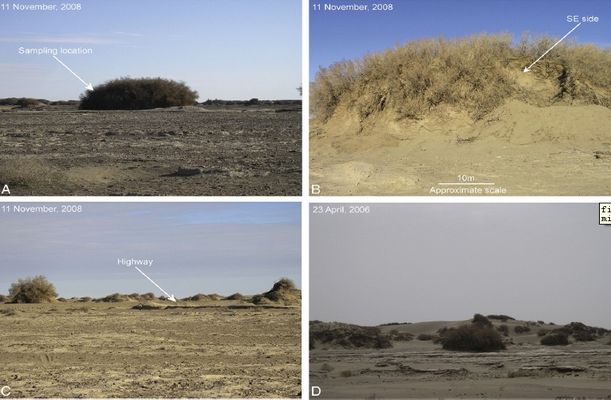Nebkha formation:Implications for reconstructing environmental changes over the past several centuries in the Ala Shan Plateau, China
Updatetime:2011-05-05From:
【Enlarge】【Reduce】
The research of Nebkha formation: Implications for reconstructing environmental changes over the past several centuries in the Ala Shan Plateau was accomplished recently by the researchers of Cold and Arid Regions Environmental and Engineering Research Institute. The researchers analyzed a typical nebkha and used the results to reconstruct changes in the regional wind regime and sediment availability, as well as the evolution of other aeolian landscapes, for a period covering the past five centuries in the Ala Shan Plateau.The research results provide relatively high-resolution data on the environmental changes that occurred in this extremely arid area.
The researchers of Key Laboratory of Desert and Desertification documented the formation and development of nebkhas and evolution of the aeolian geomorphology in the Ala Shan Plateau in response to the integrated effects of environmental changes. Nebkha sediments recorded variations in the wind regime, playa evolution, and sediment availability; δ13C values for the Tamarix chinensis litter within these sediments documented variations in the moisture conditions; and a combination of carbon dating and stable carbon isotope ratios showed that during the initial period of nebkha development, sediments accumulated rapidly and the playas evolved into gobi deserts. After the playa surfaces stabilized, the nebkha sediments documented environmental changes in the adjacent regions. In the Ala Shan Plateau, the evolution from playas into gobi deserts appeared to occur within less than 200 years. During the past five centuries, our data for the sampled nebkha suggest that the Ala Shan Plateau experienced three stages based on moisture conditions and five stages based on fluctuations in wind activity. The results also showed that the δ13C values reflected the integrated effects of multiple factors that affected moisture conditions, including the depth to the groundwater table, temperature, precipitation, evaporative demand, and other factors related to moisture conditions, such as the wind regime.
This research was supported by the National Natural Science Foundation of China (NSFC 41071008).
Photograph of the excavated nebkha. (A) Long-distance view of the nebkha and the surrounding surface. (B) A close-up view of the sampled nebkha. (C) The landscape in an area of degraded nebkhas, showing playas evolving into gobi surfaces. (D) Degraded nebkhas. (C) was located about 6 kmsouth of the excavated nebkha, and (D) was around 10 km from Ejin, but its location was not identified.(image by Palaeo)
Appendix




